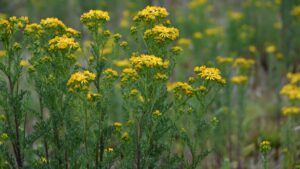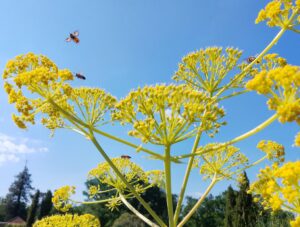
Podcast Episode 36 – The Dove From Above
PODCAST EPISODE 36: The Dove From Above Join us on a beautiful June evening for episode 36 of the Knepp Wildland Podcast. We’re joined by
Home / The Journey to Wilding the Garden ~ October 2021
The storms that finished September worked themselves into a crescendo in the first weekend of October. The ten-metre Indian bean tree (Catalpa bignonioides) left stranded in a sea of mud lay cleaved in two on the Monday morning. Whether as a result of the surrounding excavations or the lack of competition around it the tree had put on an astonishing amount of growth this season, the leaves easily measuring thirty centimetres across. The weight of vegetation and rain was clearly too much to bear in the furious buffeting winds.

The Indian bean tree after the storm
Had this occurred a little further on in time when the Pool Garden’s new planting was well established, and the hard landscaping firmly settled in, this natural process may have been seen as an opportunity for a new habitat, offering new conditions for plants and wildlife, a dynamic ecosystem in a healthy state of flux. However, since the project is at its very beginning, the groundwork only sketched in soil, our designer Tom Stuart Smith thought it best to remove the fallen limbs and roots. It would be difficult to manoeuvre around and extremely tricky to lay the crushed concrete and sand mix over the subsoil. As well as creating a range of habitats and offering garden design answers to an increasingly hotter and more extreme climate, this ‘cap’ serves as a valuable mulch. It will reduce the need for watering, conserve moisture and nutrients for plant roots and inhibit competition from latent weed seeds in the soil below.
The bones of the Pool Garden are beginning to take shape; Anthony our landscaper has now built up the tops of the irregular mounds with the subsoil taken from the various shaped hollows and lined those dips with topsoil he had removed right at the start of the groundworks. The winding paths like streams meandering through the dunes have been carved out and laid with crushed concrete which was compacted and overlaid with sand. This extends into the old ‘Acacia Walk’ which runs along the side of the Kitchen Garden, separated by the beech hedge, now trimmed into a wilder caterpillar shape, along its length. Since he’s beginning the work furthest from the only access point large enough to accommodate heavy machinery, this is the first section to be completed, giving us a sneak preview of what the rest of the new design will become. It’s a transitional area, with a gateway into the walled garden from the house and terrace, and a pathway from the Kitchen Garden to the Pool Garden. As such, it retains the original wall planting of figs, kiwis and roses, with bear’s breeches [Acanthus spinosa] and various white flowered cistus below but there will also be new plantings in the sand either side of another central path. The original turf had been removed back in July, the eight mop-headed Robinia pseudoacacia trees dug out and replanted in the wider estate. Their roots were plentiful and wide ranging, and suckering shoots with their delicate pinnate rows of leaflets began springing up through the summer. Anthony wrestled them out with the digger and broke up the compaction as he retreated, a job too far for our hand forks and elbow grease. Then came 150mm of land-based sand laid down and raked to the level perfection of a Japanese Zen Garden; it had a curious ‘memory foam’ quality when walked on. Anthony assures us this will change as the finer grains settle to the bottom during the winter rains leaving the coarser, larger grains on the surface. Those dynamic landscape engineers the burrowing worms will no doubt waste no time in pulling down material and leaving casts behind them, the oaks on the other side of the wall will carpet the sand with their shaken leaves and it will be interesting to watch how the medium develops in future in response to these natural processes.

New laid sand in Acacia Walk
Tom came for a flying visit, arriving with the last of the 2,500 Kitchen Garden plants to lay them out, most of them smaller 9cm pots. He filled out the planting in the ‘dirty paths’ with more Mediterranean herbs such as lavenders, sages and thymes, and augmented the planting in the beds with some shrubs and perennials that were unavailable in previous orders. There were more currants, red and white, some of the fabulous Chilean guava plants (Ugni molinae), an often-overlooked shrub with delicious small pink fruits you can pick into the first frosts. There was plenty of sweet woodruff (Gallium odoratum) to fill the ground cover gaps in the north- facing stable yard bed. Both the leaves and flowers are edible, the leaves used to add a fresh-mown hay scent in cold drinks, fruit salads and herbal teas, and in the Alsace region of France an aromatic tonic called ‘Maitrank’ where leaves are soaked in white wine.
We’re well into Autumn now, the later rising sun making acid yellow, rose pink, powder blue and tangerine orange skies. Wraiths of mists hover just above the fields, jackdaws rising distinct as black paper cut-outs. The reeds in the lake are russet as a fox’s tail, the perfect setting for All Hallows’ Eve. The Christian feast of the 31st of October marks the observance of Allhallowtide, when saints (hallows) are remembered along with martyrs and the departed. It is also an older Gaelic pagan celebration of the end of harvest and the beginning of winter called Samhain, where spirits were appeased with food and drink to help their families and livestock survive through the harsher months, and a place set at the table for the souls of dead relatives. The rhythm of the natural world is something people have been more connected with since the pandemic slowed us down and forced us to look around us a little more. While we’re carving pumpkins and preparing bowls of sweets, we are minded to hold a memory of the garden that came before and give a nod to those sprites of nature to shepherd the new garden through till Spring arrives.
Moy Fierheller Joint Head Gardener October 2021
What we’re reading
Independent Plant Nurseries Guide
Updated Peat-Free Nurseries List – Nic Wilson (dogwooddays.net)
Home – Organic Growers Alliance

PODCAST EPISODE 36: The Dove From Above Join us on a beautiful June evening for episode 36 of the Knepp Wildland Podcast. We’re joined by

Matt Phelps | Lead Ecologist It’s mid-June and the countryside is quietly gearing up for its summer crescendo. You might have noticed it already— what

Moy Fierheller | Deputy Head Gardener Visit Knepp’s rewilded Walled Garden The fine, fairy-tale spring continues and the Met Office reports it’s the sunniest in
Knepp Wildland Safaris, our gardens and campsite are all about the quiet and patient observation of nature.
Some of the species we are likely to encounter are shy or can be frightened by loud noises or sudden movements. Our campsite with open-air fire-pits, wood-burning stoves and an on-site pond is unsuitable for small children.
For this reason, our safaris, garden visits, holiday cottages and campsite are suitable only for children of 12 and over.